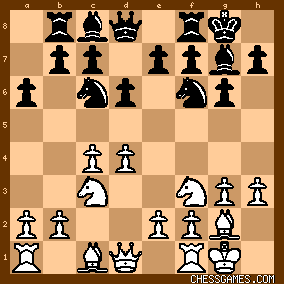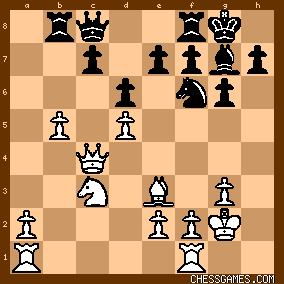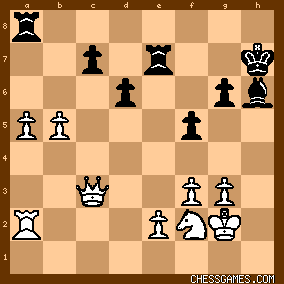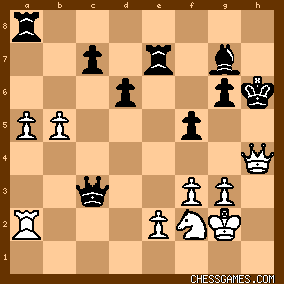|
< Earlier Kibitzing · PAGE 3 OF 3 ·
Later Kibitzing> |
Jul-12-11
 | | LIFE Master AJ: I started annotating this game ... maybe I can finish it later on today. (Its 07:02 AM and I have to run ...) |
|
| Jul-12-11 | | Fuegoverde: 32 Rxh6+ Bxh6, 33 Qxc3 or 32...Kxh6, 33 Qh4++ Nice and easy! |
|
| Jul-12-11 | | Patriot: It's an easy puzzle, but to see stuff like this regularly during games a good thought process is needed. Likewise a good thought process is needed to avoid moves like 31...Qc3? for black. |
|
| Jul-12-11 | | PinnedPiece: Tuesday Goal: Solve in 1 minute
By 1 minute, I had decided that the rook sac on h6 was <probably the solution>, but IT TOOK ME ANOTHER MINUTE TO DETERMINE WHY!!! Result: fail (flag fell). |
|
| Jul-12-11 | | Chessfanatic100: Haven't been through the game but i saw Rxh6 immediately |
|
| Jul-12-11 | | agb2002: White has a knight for a bishop.
Black threatens 32... Qxc4.
The bishop is overworked, defending the queen and the spot h6. Therefore, 32.Rxh6+ Bxh6 (32... Kxh6 33.Qh4#) 33.Qxc4 + -. |
|
| Jul-12-11 | | ROO.BOOKAROO: This is a good illustration that one move can be at the same time an example of many tactical concepts.
The check 32. Rxh6+ by White is of course a "sacrifice"; but it can also be described as "removing the guard" (the bishop on g7, guarding the Black Queen on c3); it also is a "deflection" (of the B on g7 from its line of action, the big diagonal a1-h8); it is "overloading" the Bishop as well (guarding both the c3 square and covering the h6 square where the check is delivered); and it is also a kind of "zwischenzug" (instead of immediately taking the opponent's queen on c4, White interposes a check that allows the capture of the Black queen without a risk of recapture). |
|
| Jul-12-11 | | e fred: What about
31....Bd4
White must go to defense. |
|
| Jul-12-11 | | mworld: doesn't get much easier than this one. |
|
| Jul-12-11 | | kevin86: A little easy for Tuesday (almost a Monday night puzzle: 32 ♖xh6+ wins easily
if 32...♔xh6 33 ♕h4# or if ♗xh6 33 ♕xc3
All other black moves are better...except there ain't none... |
|
Jul-12-11
 | | scormus: 31 .... Be careful where you place your Q |
|
| Jul-12-11 | | harish22: Guess in this case "Black on not Ok".
A classic case of seeing the strategy but overlooking the tactics. White attacks on both the wings. On the open h file and pawns on the queen side. Black plans to exchange the queen to diffuse the white's attack on his king and transfer his bishop to a5 or b6. Black plays f5 to kick the knight of so that the queen can be exchanged at Qc3 and expand his pawn. Misses that it opens up the c4-g8 diagonal. And falls to a one shot combo. Adorjan must have been complimenting himself on Qc3. He was forcing the trade of queen by attacking a5. Had he looked closer, he may have played Qd4. |
|
Jul-12-11
 | | Sneaky: For about one or two seconds I thought this: "I can win at least a pawn with Rxh6+ because if Kxh6 then Qh4+ is a fork, winning back the rook on e7." Kind of funny, to think you are winning a pawn when in fact you're winning the king. Incomplete logic like that can help you in bullet chess, where you can stumble into the best variation for the wrong reasons. |
|
| Jul-12-11 | | Nullifidian: Winning the queen for a rook with a removal of the guard sac: 32. ♖xh6+ ♗xh6 (♔xh6 33. ♕h4#) 33. ♕xc3 |
|
Jul-12-11
 | | Phony Benoni: <sdbra: <Phony Benoni> Is it an overloaded king or an overloaded bishop (which protects the h-pawn and the queen)?> You're right, of course. I was just being silly. But I do like to look at things differently. |
|
| Jul-12-11 | | TheFocus: Ten seconds to solve this. Not bad for a Tuesday puzzle. |
|
| Jul-12-11 | | wals: Rybka 4 x 64: d 21 : 1hr 27 :
OOPS
31...Qc3, +9.89.
Best,
1.  (1.27): 31...Rd8 32.Nd3 Bd4 33.a6 g5 34.Rf1 Rg8 35.Kh2 g4 36.Qd5 Rg5 37.Nf4 Ba7 38.Qd3 Qxd3 39.exd3 Re5 40.fxg4 fxg4 41.Rc2 Rg7 42.Rb2 Rf7 (1.27): 31...Rd8 32.Nd3 Bd4 33.a6 g5 34.Rf1 Rg8 35.Kh2 g4 36.Qd5 Rg5 37.Nf4 Ba7 38.Qd3 Qxd3 39.exd3 Re5 40.fxg4 fxg4 41.Rc2 Rg7 42.Rb2 Rf7 2.  (1.38): 31...h5 32.a6 Kh6 33.Nd3 Bd4 34.Rf1 Qe6 35.Qxe6 Rxe6 36.Rd1 Ree8 37.Nf4 Bc5 38.Re1 Reb8 39.Ne6 Ra7 40.Nxc5 dxc5 41.Ra5 Rb6 (1.38): 31...h5 32.a6 Kh6 33.Nd3 Bd4 34.Rf1 Qe6 35.Qxe6 Rxe6 36.Rd1 Ree8 37.Nf4 Bc5 38.Re1 Reb8 39.Ne6 Ra7 40.Nxc5 dxc5 41.Ra5 Rb6 30...f5, +1.27, (Best, Rd8, +0.90.)
didn't help. |
|
| Jul-12-11 | | newton296: I was only 4 when this game was played!
anyway, who are these dudes! cause I think I played this guy on playchess? and I landed about 10 combos just like this one just today! lol ! took me about 20 seconds to thump this one out! |
|
| Jul-12-11 | | VincentL: "Easy".
32. Rxh6+ must be the solution.
(a) 32....Bxh6 33. Qxc3
(b) 32....Kxh6 33. Qh4 mate.
I don´t see any other move for black.
Let´s check. |
|
| Jul-12-11 | | zb2cr: Coming late to the party, I see 32. Rxh6+ as the move. If Black retakes with the King, then 33. Qh4#. If Black retakes with the Bishop, then his Queen at c3 is unguarded and White wins Queen for Rook. |
|
| Jul-12-11 | | James Bowman: Not fair too simple remove the defender with check really what day is his Tuesday? All right I'm just blind I saw Rx6+ and somehow failed to realize that it was mate or lose the Queen, I was looking at the rook on e6. That's what you get for trying to steal a hamburger when there is a porter house steak on the table. |
|
Jul-12-11
 | | LIFE Master AJ: GM Jan Smejkal (2515)
- GM Andras Adorjan (2465) / [E63]
FIDE Zonal Tournament (zt)
Vrnjacka Banja, Yugoslavia; (R#13) / 1972.
[A.J.G.]
POTD / Tuesday; July 12th, 2011
1.d4 g6; 2.c4 Nf6; 3.Nf3 Bg7; 4.g3 0-0; 5.Bg2 d6; 6.0-0 Nc6; So far we have a King's Indian, where White has fianchettoed his (light-squared) King's Bishop. 
click for larger view This line was all the rage (in the 1940's and the 1950's); however, Black won a rash of brilliant games, and for 30 years (or more) few top GM's were willing to play this line. 7.Nc3 a6; 8.h3 Rb8;
Nowadays, it seems that play almost always heads into the complex Panno System. 
click for larger view 9.Be3,
White plays a natural developing move, keeping his center flexible. [ One fairly topical reference (instead) give the following continuation for White:
9.e4 Nd7; 10.Be3 Na5; 11.b3 b5; 12.cxb5 axb5; 13.Qd2 b4; 14.Nd5,  and White has a slight edge. and White has a slight edge. [ See MCO-15, page # 622; column # 68, and all notes. ] ] 9...b5!; (4 opening principles)
Black, who suffers from a slight disadvantage in space, must gain some himself. In doing this, he also chips away at White's center and gains some needed counterplay. 10.Nd2 Bd7; 11.d5!?,
White locks the center, to a certain degree, both KB's are now shut out of play. 
click for larger view One of the advantages of d4-d5 for White is that it disrupts Black's position and forces his QN onto the edge of the board. [ The "Power-Book" gives: 11.Rc1, "  " as being the main line, while 11.b3 " as being the main line, while 11.b3  , has scored well recently. ] , has scored well recently. ] The intro to the middlegame proceeds pretty normally for a game of this line. 11...Na5; 12.cxb5 axb5; 13.b4! Nc4; 14.Nxc4 bxc4; 15.b5 Qc8; 16.Qa4! Bxh3; 17.Qxc4 Bxg2; 18.Kxg2, White has played well so far.

click for larger view I would say that the position is close to equal, Black has a compact pawn structure and good play; while White has space and an outside passed Pawn for the endgame. |
|
Jul-12-11
 | | LIFE Master AJ: GM Jan Smejkal (2515)
- GM Andras Adorjan (2465) / [E63]
FIDE Zonal Tournament (zt)
Vrnjacka Banja, Yugoslavia; (R#13) / 1972.
[A.J.G.]
POTD / Tuesday; July 12th, 2011
(Part II)
18...e6!?;
Fritz prefers 18...Qg4; here. (I agree.)
White's next move is correct, when Fritz likes 19...Ra8; for Black. 19.Rad1 Qb7; 20.Bg5!?, ('?!')
White looks to pressure Black on the K-side, but this move may have been inaccurate. [ Better was: >/= 20.a4,  which gives White a tiny edge. ] which gives White a tiny edge. ] Now Fritz likes 20...Nd7; here, but Black's move wasn't bad.
20...Rfe8, "=" (Maybe "  ") ")
Black is OK here.
Now, instead of the move in the game, the box prefers 22.e4. 21.Bxf6 Bxf6; 22.Ne4 Bg7; 23.a4 Ra8; 24.f3!?,
This anchors the Knight on e4, but maybe 23.dxe6, '=' was better than the move in the actual game. 
click for larger view 24...h6?!; (Maybe - '?')
Instead of this poor move, the immediate 24...f7-f5!; probably gave Black the upper hand. 25.dxe6 Rxe6; 26.Rd2 Re7; 27.Rc1 Qa7; 28.Ra2 Kh7?!; No need for this, the box likes putting the BQ on b6 ... I think this looks like the better play. 29.Rh1 Qe3; 30.a5 f5; 31.Nf2T, Forced. ("▢") 
click for larger view Black was slowly getting the worse of things, although his game was far from lost. [ Much worse / unacceptable was: 31.Nd2?? Qxe2+; etc. ] 31...Qc3?; (Probably even - '??')
Now poor Adorjan walks right into a sucker-punch. (Was this a mistake made in time trouble?) 
click for larger view This is the position for our POTD.
[ >/= 31...Bd4▢; 32.Nd1 Qe6▢; 33.Qxe6 Rxe6; 34.Rh4±. ( "  ") ] ") ] 32.Rxh6+! , Black Resigns.
Looks like "Bishop takes Rook" ... (which drops the Queen) ... was forced, unless Black prefers to play 32...Kxh6; 33.Qh4#. A nice game by Smejkal, although Black was guilty of pouring gasoline on a roaring fire ... 1 - 0 |
|
Jul-12-11
 | | FSR: After 32.Rxh6+!, Black is <not> OK. |
|
| Mar-23-16 | | notyetagm: Smejkal vs Adorjan, 1972 32 ?

click for larger view32 ♖h1xh6+! 1-0 <overloaded: c3 & h6>

click for larger view(CONTINUATION)
32 ... ♗g7x♖h6 33 ♕c4x♕c3 <deflection: c3>

click for larger view32 ... ♔h7x♖h6 33 ♕c4-h4#

click for larger view |
|
 |
 |
|
< Earlier Kibitzing · PAGE 3 OF 3 ·
Later Kibitzing> |





